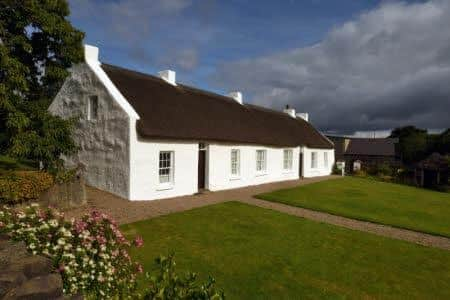Damp found in 17th century Hezlett House is putting the future of one of Northern Ireland’s oldest buildings at risk
and live on Freeview channel 276
The future of one of Northern Ireland’s oldest buildings is at risk after damp was discovered in the original timber frame of the 17th century property.
Now owned by the National Trust, Hezlett House near Castlerock dates back to 1691 and is regarded as one of the best preserved vernacular buildings of the Plantation period still standing.
Advertisement
Hide AdAdvertisement
Hide AdHowever the iconic thatched cottage near Downhill Demesne needs repair work to restore the structure which could cost the charity thousands of pounds.


At present a building surveyor is assessing the damage and has confirmed: “Immediate plans are to address any issues uncovered from the investigation works, ensuring the buildings long term future and the cost will depend on what we find from investigation works.”
The worrying assessment is contained in documents accompanying an application to planners for Listed Building Consent to carry out investigation work.
It states: “At present if no works are undertaken there will be continued deterioration and ultimately loss of the historic fabric.”
Advertisement
Hide AdAdvertisement
Hide AdTo help with the costs of restoring the property, the National Trust have an on-going fundraising text-to-donate number and is welcoming donations.
Highlighting works are ‘at very early stage of investigation’, a National Trust spokesperson, continued: “We’re currently taking the relevant measures to establish any repair work required at Hezlett House, with the investigation taking place in the immediate future. These investigation works will provide a full understanding of any issues and guide any future repair works required, securing the buildings long term future.”
Highlighting the importance of Hazlett’s long history, which attracts thousands of local and global visitors each year, the National Trust website states: “The single-storey thatched cottage dates from 1691 when it was probably built as a parsonage for the rector of Dunboe. The walls are built of uncoursed rubble with roughcast and a core of earth and sand. The house is particularly interesting for its cruck construction, a form not often seen in Northern Ireland at this date. Several areas in the house are left bare to expose the cruck trusses and other structural details. In 1761 the house was acquired by a Presbyterian farmer, Isaac Hezlett, whose family continued to live there until the National Trust acquired the property in 1976.”
Hezlett House also houses a collection of 632 items which are on display at the property and includes ‘the broken relics of the sculpture collection once owned by the Earl Bishop at Downhill’.
Advertisement
Hide AdAdvertisement
Hide AdThe Trust website continues: “The museum display explains the cruck construction; and a collection of mid-Victorian furnishings, some from the house and others brought in. Also housed at Hezlett are the broken relics of the sculpture collection once owned by the Earl Bishop at Downhill. Once a fine collection of sculpture brought from Italy in the late 18th century, the collection was later dispersed and partly destroyed in a fire at Downhill in the 19th century, the broken fragments gradually dug into the gardens from whence they occasionally emerge.”
Anyone who wishes to make a donation should text: DOWN to 70525.